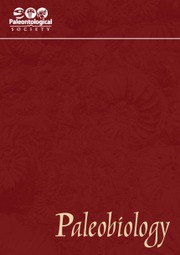Crossref Citations
This article has been cited by the following publications. This list is generated based on data provided by
Crossref.
Bell, Michael A.
1984.
Evolutionary Genetics of Fishes.
p.
431.
Bell, Michael A.
Baumgartner, Jeffrey V.
and
Olson, Everett C.
1985.
Patterns of temporal change in single morphological characters of a Miocene stickleback fish.
Paleobiology,
Vol. 11,
Issue. 3,
p.
258.
Gingerich, Philip D.
1985.
Species in the fossil record: concepts, trends, and transitions.
Paleobiology,
Vol. 11,
Issue. 1,
p.
27.
Levinton, J. S.
Bandel, K.
Charlesworth, B.
Müller, G.
Nagl, W.
Runnegar, B.
Selander, R. K.
Stearns, S. C.
Turner, J. R. G.
Urbanek, A. J.
and
Valentine, J. W.
1986.
Patterns and Processes in the History of Life.
p.
166.
Koch, Paul L.
1986.
Clinal geographic variation in mammals: implications for the study of chronoclines.
Paleobiology,
Vol. 12,
Issue. 3,
p.
269.
BELL, MICHAEL A.
1987.
Interacting evolutionary constraints in pelvic reduction of threespine sticklebacks, Gasterosteus aculeatus (Pisces, Gasterosteidae).
Biological Journal of the Linnean Society,
Vol. 31,
Issue. 4,
p.
347.
Bell, Michael A.
Wells, Christina E.
and
Marshall, James A.
1989.
MASS‐MORTALITY LAYERS OF FOSSIL STICKLEBACK FISH: CATASTROPHIC KILLS OF POLYMORPHIC SCHOOLS.
Evolution,
Vol. 43,
Issue. 3,
p.
607.
Fenster, Eugene J.
Sorhannus, Ulf
Burckle, Lloyd H.
and
Hoffman, Antoni
1989.
Patterns of morphological change in the Neogene diatomNitzschia jouseaeBurckle.
Historical Biology,
Vol. 2,
Issue. 3,
p.
197.
McCune, Amy Reed
1990.
EVOLUTIONARY NOVELTY AND ATAVISM IN THE
SEMIONOTUS
COMPLEX: RELAXED SELECTION DURING COLONIZATION OF AN EXPANDING LAKE
.
Evolution,
Vol. 44,
Issue. 1,
p.
71.
Reimchen, T. E.
1992.
INJURIES ON STICKLEBACK FROM ATTACKS BY A TOOTHED PREDATOR (ONCORHYNCHUS) AND IMPLICATIONS FOR THE EVOLUTION OF LATERAL PLATES.
Evolution,
Vol. 46,
Issue. 4,
p.
1224.
Barton, Douglas G
and
Wilson, Mark VH
1999.
Microstratigraphic study of meristic variation in an Eocene fish from a 10 000-year varved interval at Horsefly, British Columbia.
Canadian Journal of Earth Sciences,
Vol. 36,
Issue. 12,
p.
2059.
Emry, Robert J.
Korth, William W.
and
Bell, Michael A.
2005.
A tree squirrel (Rodentia, Sciuridae, Sciurini) from the Late Miocene (Clarendonian) of Nevada.
Journal of Vertebrate Paleontology,
Vol. 25,
Issue. 1,
p.
228.
Bell, Michael A.
Travis, Matthew P.
and
Blouw, D. Max
2006.
Inferring natural selection in a fossil threespine stickleback.
Paleobiology,
Vol. 32,
Issue. 4,
p.
562.
Hunt, Gene
Bell, Michael A.
and
Travis, Matthew P.
2008.
EVOLUTION TOWARD A NEW ADAPTIVE OPTIMUM: PHENOTYPIC EVOLUTION IN A FOSSIL STICKLEBACK LINEAGE.
Evolution,
Vol. 62,
Issue. 3,
p.
700.
Bell, M. A.
2009.
Implications of a fossil stickleback assemblage for Darwinian gradualism.
Journal of Fish Biology,
Vol. 75,
Issue. 8,
p.
1977.
Nazarkin, Mikhail V.
Yabumoto, Yoshitaka
and
Urabe, Atsushi
2013.
A New Miocene Three-Spined Stickleback (Pisces: Gasterosteidae) from Central Japan.
Paleontological Research,
Vol. 16,
Issue. 4,
p.
318.
Bindeman, I. N.
Zakharov, D. O.
Palandri, J.
Greber, N. D.
Dauphas, N.
Retallack, G. J.
Hofmann, A.
Lackey, J. S.
and
Bekker, A.
2018.
Rapid emergence of subaerial landmasses and onset of a modern hydrologic cycle 2.5 billion years ago.
Nature,
Vol. 557,
Issue. 7706,
p.
545.
Gingerich, Philip D.
2019.
Rates of Evolution.
Hudson, Cameron M.
Lucek, Kay
Marques, David A.
Alexander, Timothy J.
Moosmann, Marvin
Spaak, Piet
Seehausen, Ole
and
Matthews, Blake
2021.
Threespine Stickleback in Lake Constance: The Ecology and Genomic Substrate of a Recent Invasion.
Frontiers in Ecology and Evolution,
Vol. 8,
Issue. ,
Siddiqui, Raheyma
Swank, Samantha
Ozark, Allison
Joaquin, Franklin
Travis, Matthew P.
McMahan, Caleb D.
Bell, Michael A.
and
Stuart, Yoel E.
2024.
Inferring the evolution of reproductive isolation in a lineage of fossil threespine stickleback,
Gasterosteus doryssus
.
Proceedings of the Royal Society B: Biological Sciences,
Vol. 291,
Issue. 2021,

